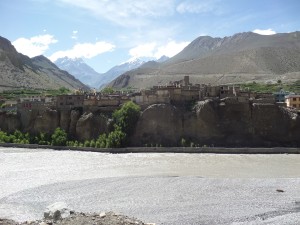I am always surprised at how quickly time flies during fieldwork, and paradoxically, how slowly it passes from day to day. With only a few weeks left for this summer’s current project here in the high Himalayas of Nepal, it’s time to take stock of my fieldnotes to date and make a plan for the days remaining. My guide and I will be leaving Kagbeni on Monday for Jomsom (and by that token, Marpha, an important village in this region which we will also have the chance to visit), leaving me only a few days left here at the main geographical source of the sacred Shaligram Stones.
I will miss Kagbeni. For as fascinating and ethnographically productive as Muktinath is, I find I feel almost more at home here on the wind-swept banks of the Kali-Gandaki River. Perhaps there is just something deeply appealing to me about slogging my way merrily through mud and silt in search of ancient fossils with a group of excited Hindu pilgrims and sadhus, or perhaps it is just reminiscent enough of my rural childhood to keep me perpetually coming back for more.
But the real endeavor now is to solidify my themes and focus on my most important questions. I can already see four particularly salient categories popping up over and over again: what I am calling The Social Life of Stones, The Semiotics of Stones, Mobility as Power (or, Sacred Landscapes in Conflict with Political Landscapes), and “Modernity” versus “Tradition.” For those of you at all familiar with anthropological work in South Asia, some of this will seem reasonably familiar, especially the last theme. If nothing else, using these headings helps me to organize everything from multiple mythical origin stories, references from competing Vedic texts on the identification of Shaligram Stones, sketches and descriptions of the stones themselves, stories and experiences of pilgrims, and my own observations of ritual practices and uses of sacred space. But what is more, what I see is this project truly shaping up around issues of mobility and movement, which I mentioned earlier, and I think that this approach could potentially produce something truly exceptional in the genre of ethnographic writing (eventually anyway). But of course, as with any fieldwork, something could yet come up that completely changes everything. Such things happen more often than you might think.
In any case, I will be traveling to Tiri village a few kilometers north of here as of yet, revisiting the Shiva mandir in Kagbeni that currently houses several rather enormous sacred stones, and undertaking a few more Shaligram pilgrimages before I go. For just as the stones must travel, so must I.


Congratulations to all of us who love peace and democracy. Thank you Girije, flalniy you did something to remember in the history of New Nepal. The day of Monarch power has been replaced by Peoples’ power. We are no longer suject of Baksishs. However, the difficult road has just began. Prachanda, now its your turn to show Nepalis people you also also love to seen prosperous democratic Nepal, not outdated sigle Communist regime. Lets build our country for good so we not long have to beg from others. We will held our head high. This is the time to come together for good. But we still have warn the leaders constantly to keep them on track. It will not take much before they again become currupts look the Shere Deuba’s team. They cant decide on cabinet members. Publicly know currupt C Wagle, B. K Gachadar, Bal B KC and .are fighting to for cabinet posts.long live democracy.